Of all the American motion pictures
entitled to be designated great on the basis of all their qualifications,
including the extent of the excitement they have caused, one towers above
all the rest. That is the massive screen production of the Civil War novel,
Gone with the Wind.
Never before or since its making has so much attention been fixed upon the
urgency and the responsibility of bringing a film into being. Never has the
public's interest been so attracted in the preparation stage, and never has a
national volition been so generously fulfilled and satisfied. I strongly suspect
a great deal of the "Civil War cult" of later years was seeded in the shaky
1930's by Margaret Mitchell's huge, nostalgic novel and the film made from it.Miss Mitchell's novel was published
in 1936 and burst upon the literary world as one of those sudden sensations that
come only occasionally. Its heroine, Scarlett O'Hara, the pampered Georgia girl
who emerged a tough and gaudy phoenix out of the smoldering ashes of the Civil
War, swiftly became the most impressive, exciting, fascinating, discussed and
certainly the most romantic female of the day. Inevitably, the production of a
motion picture from such a successful book was a matter for popular speculation. And the fact that David 0. Selznick had acquired the screen rights for a mere
$50,000 before the novel was published was the first of many extraordinary
developments in the saga of its transfer to the screen.
Selznick, a first-class showman and a
gifted producer, was not slow in realizing what a remarkable property he had
obtained. But even he was slow in grasping the great potential of Gone with
the Wind. By the end of the year of publication, he had got from the
distinguished playwright, Sidney Howard, a rather full treatment for a
screenplay and had begun to think of casting the film. But the magnitude of the
sales of the novel and the spontaneous surge of public interest in who would
appear in the movie caused him to pause.
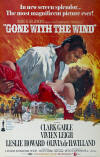
 Almost from the beginning, the actor
who leaped to mind as the only one to play Rhett Butler, the picaresque hero,
was the tremendously popular
Clark Gable. However, Gable was under contract to
Metro-Goldwyn-Mayer, which was not inclined to loan him to an independent
producer, except for a formidable quid pro quo: an arrangement
whereby the big studio would finance and distribute the film. Since Selznick had
a contract to release his films through United Artists until 1939, this meant
that Gone with the Wind could not be distributed by another company until
after that date. So Selznick, bent on getting Gable, was compelled to delay for
two years.
Almost from the beginning, the actor
who leaped to mind as the only one to play Rhett Butler, the picaresque hero,
was the tremendously popular
Clark Gable. However, Gable was under contract to
Metro-Goldwyn-Mayer, which was not inclined to loan him to an independent
producer, except for a formidable quid pro quo: an arrangement
whereby the big studio would finance and distribute the film. Since Selznick had
a contract to release his films through United Artists until 1939, this meant
that Gone with the Wind could not be distributed by another company until
after that date. So Selznick, bent on getting Gable, was compelled to delay for
two years.
The time was used to good advantage
in expanding the production plans, exploring casting arrangements, working with
various writers on the script and especially in contemplating the burning
question of who was to play Scarlett. This was another issue that concerned the
public greatly. But even as late as December 1938, Selznick had not reached a
decision as to who would play the role. And, by then, he had completed
arrangements to begin shooting.
The location for the filming was to
be the Pathé lot in Culver City, not far from Metro-Goldwyn-Mayer. To clear this
lot of some old standing sets in order to make way for the construction of the
plantation mansions of Tara and Twelve Oaks and the Atlanta buildings and
streets, the art director, William Cameron Menzies, proposed that the old sets
be brought down in a monstrous nighttime conflagration which could be
photographed to constitute the big scene of the burning of Atlanta, a climax in
the film. This heroic suggestion was enthusiastically embraced. Two stunt men
were engaged to ride in an old wagon in front of the burning sets to represent
in long shot the flight of Rhett and Scarlett (and Melanie Wilkes and her
newborn child) out of the defeated city.
The scene was shot on the night of
December 10, 1938. And on that night, while Atlanta was burning, Myron Selznick,
David's brother, came on the lot with Vivien Leigh, a beautiful green-eyed
British actress, and casually presented her to the preoccupied producer as "your
Scarlett." It was an arresting, dramatic gesture that Selznick could not resist. He there and then decided that Miss Leigh was to have the role.
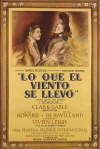
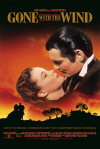 Three weeks after shooting started in
the spring of 1939, the director, George Cukor, was taken off and Victor
Fleming, a close friend of Gable, was given the job. Fleming died a few weeks
before completion and Sam Wood was rushed in to finish the film. Finally, on the
night of December 14, 1939, the mighty Wind was given a triumphant world
premiere in Atlanta, Miss Mitchell's home town. Its length was three hours and
forty-five minutes, the longest film released in the United States up to that
time.
Three weeks after shooting started in
the spring of 1939, the director, George Cukor, was taken off and Victor
Fleming, a close friend of Gable, was given the job. Fleming died a few weeks
before completion and Sam Wood was rushed in to finish the film. Finally, on the
night of December 14, 1939, the mighty Wind was given a triumphant world
premiere in Atlanta, Miss Mitchell's home town. Its length was three hours and
forty-five minutes, the longest film released in the United States up to that
time.
Its reception was tremendous. But for
all the public enthusiasm and critical acclaim, no one then dreamed how popular
and culturally momentous it would be. It has been the most widely circulated,
the most often seen, the most profitable film ever made―and that includes
The Birth of a Nation, to which it bears an astonishing resemblance in many
significant ways.
The eminence of this picture is in
the richness with which it conveys a universally recognizable portrait of a
many-faceted female character within a vast and tumultuous panorama of socially
exciting events. But Gone With the Wind is more than the exposure
of a vivid character, more than a superfluity of adventure, romance and
spectacle. It is a superior illustration of a large chunk of American legend and
myth, a grand illusion of imagined people living through a nostalgia-drenched
experience.
The first title sets the stage
succinctly. "There was a land of cavaliers and cotton fields in the Old South,"
it says; and this conception, echoing folklore and Stephen Foster songs, states
the romantic environment in which the drama begins. No attempt to suggest the
full reality of the antebellum South is made, or to give an intelligent
comprehension of the causes of the American Civil War. This is solely an outline
of the cruel "War Between the States" as it affects and alters the course of the
life of a self-centered girl. It is in no sense documentary. On the contrary, it
is a purely selective arrangement and coloration of historical events. But the
hints of these events are so evocative, so skillfully realized, they have the
effect of seeming at least to articulate history.
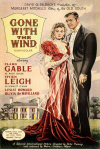
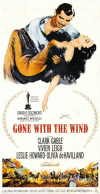 I will not attempt to detail or
analyze the plot of this long-drawn, narrative-patterned drama. Rather I will
indicate key scenes in which the character of Scarlett is realized in the great
flow of events, and the illusion of history in the making is most forcibly
achieved.
I will not attempt to detail or
analyze the plot of this long-drawn, narrative-patterned drama. Rather I will
indicate key scenes in which the character of Scarlett is realized in the great
flow of events, and the illusion of history in the making is most forcibly
achieved.
There is the scene of the charity
ball in Atlanta, at which money is being raised for the families of the fallen
heroes in the early days of the war, and Scarlett, the belle of the plantations,
in widow's weeds, flirts openly and maliciously with the debonair blockade
runner, Rhett. To her this is still but an extension of the mannered socializing
of her youth.
And then there is the scene of the
reading of the casualty lists after Gettysburg, with Scarlett, fearing to find
the name of her adored Ashley Wilkes among them, standing detached and aloof
amid a group of mothers and young wives sobbing softly, while a band made up of
boys and led by an elderly home guardsman defiantly strikes up "Dixie."
Some have professed disappointment
that there are no big battle scenes, no thundering clashes of armies to convey
the bloodiness of the Civil War. But the omission was judicious, for such would
only distract from the concentration on Scarlett and her growing awareness of
privation and defeat. And no battle scenes could be more eloquent of the
butchery and agony of that war than the scenes in which Scarlett, working as a
ladylike volunteer in a military hospital in Atlanta, observes the hideously
wounded men, watches a homesick boy die and is called upon to assist in a
meat-ax amputation of a gangrenous leg. Nor could anything be more eloquent of
the wretchedness of the Confederacy's collapse than the scene of Scarlett,
trying to find the family doctor to deliver the baby of Melanie Wilkes, moving
among a horde of wounded men lying unattended and helpless on the cobblestones
of a public square.
It is from this scene that the
strongest and most expressive phase of the picture extends―the phase recounting
the burning and fall of Atlanta and Scarlett's return to the desolation of the
family plantation, Tara, in defeat. And the depth of her disillusion is
portrayed in a devastating scene where she goes out into a barren field, vomits,
gets down on her knees, puts her brow against the earth and cries in anguish:
"As God is my witness, I'm going to live through this, and when it's over, I'll
never be hungry again!"
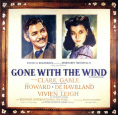
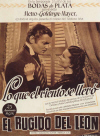 The succeeding phases of the film are
in appropriately different, more materialistic and sardonic veins. The first,
which covers the period of Reconstruction, is sturdy and often droll. It has a
determined Scarlett, busying about Tara, working the fields with Melanie,
scolding her and Mammy, the faithful servant, for taking care of passing
Confederate home-goers, chasing the renegade ex-foreman and his "white trash"
wife off the place, and then shooting the Union Army deserter, who has come to
loot and rape, shooting him full in the face with an old horse pistol as he
threateningly ascends the stairs. "Well, I guess I've done murder," says
Scarlett. "Well, I guess I won't think about that. I'll think about that
tomorrow"―as she purloins the dead man's pocketbook, stuffed with greenbacks and
gold pieces with which we are led to assume she gets Tara going again.
The succeeding phases of the film are
in appropriately different, more materialistic and sardonic veins. The first,
which covers the period of Reconstruction, is sturdy and often droll. It has a
determined Scarlett, busying about Tara, working the fields with Melanie,
scolding her and Mammy, the faithful servant, for taking care of passing
Confederate home-goers, chasing the renegade ex-foreman and his "white trash"
wife off the place, and then shooting the Union Army deserter, who has come to
loot and rape, shooting him full in the face with an old horse pistol as he
threateningly ascends the stairs. "Well, I guess I've done murder," says
Scarlett. "Well, I guess I won't think about that. I'll think about that
tomorrow"―as she purloins the dead man's pocketbook, stuffed with greenbacks and
gold pieces with which we are led to assume she gets Tara going again.
There's the return of Ashley;
Scarlett's shameless attempt to get him to run away with her; her visit to the
jail in Atlanta, dressed up in makeshift clothes, to try to get money from Rhett
with a halfhearted offer of herself; her marriage to the well-behaved Frank
Kennedy and their beginning to accumulate wealth with a sawmill worked by cheap
convict labor which she persuades a reluctant Ashley to arrange. There is also
the tense, dramatic episode of a Ku Klux Klan raid on Shantytown, where Scarlett
has been molested; the wounding of Ashley and the killing of Frank. All this is
good pictorial narration. But the apex of the story is past.
And now comes the final phase, in
which Scarlett agrees to marry Rhett, whose interest in her has continued; goes
on a honeymoon to New Orleans, returns to Atlanta to bear his child and settles
with contented ostentation into the role of a vulgar nouveau riche,
offensive to the Old Guard society, which Rhett rather wishes to embrace; and,
finally, after a series of personal disasters, is deserted by Rhett.
In this phase, the hurt and
disappointment the selfish woman causes the now regenerate Rhett is the only
advancement of comment, and this is rather skimpy and confused because the
forcefulness of Gable's performance, capped by his parting shot, "I don't give a
damn!", belie the purport that Scarlett has cruelly damaged him. The chief
structural weakness of the picture is the jumble of nonessentials in the last
phase. We've had enough of Scarlett―and Rhett, too―long before the end. However,
this needless extension of the weaker latter part of the book isn't so much of
an anticlimax that it submerges that major and mighty middle part.

_NRFPT_18_small.jpg) Naturally, there may be some
objection among those who see it today that its sympathies are mainly directed
to a class of people that has been historically discredited―that is, the
southern slave owners who were rightly dispossessed by the war and whose next
generation generally brought forth a middle class of white supremacists. But
this is no reason for resisting it as a powerful film than the same reason is
for resisting
The Birth of a Nation
as a pioneer work of cinema art.
Naturally, there may be some
objection among those who see it today that its sympathies are mainly directed
to a class of people that has been historically discredited―that is, the
southern slave owners who were rightly dispossessed by the war and whose next
generation generally brought forth a middle class of white supremacists. But
this is no reason for resisting it as a powerful film than the same reason is
for resisting
The Birth of a Nation
as a pioneer work of cinema art.
Scarlett is a vibrant human being, as
passionately played by Miss Leigh, sharply and honestly reflective of a tangle
of selfishness and sentiment. Rhett is a rich, romantic rascal in Gable's
strongly muscled hands, and
Leslie Howard's Ashley Wilkes and
Olivia de Haviland's Melanie are true exponents of noble ideals. Colorful representations
of lesser characters are given by
Thomas Mitchell as Scarlett's father, Hattie
McDaniel as her Negro nurse, Ona Munson as a bordello madam,
Butterfly McQueen
as a Negro servant, and many more. The sets, the costumes, the music by Max
Steiner and the color are tributes to craft.
There have been more ambitious, more
expensive and longer historical-spectacle films made in the years since this
one. And there have been a few that have had more critical réclame. But there
has never been one more effective than Gone with the Wind. There may
never be.
